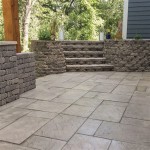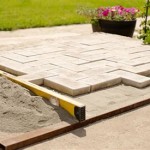Patio Building Plans: A Comprehensive Guide
Patio building plans serve as the blueprint for creating a functional and aesthetically pleasing outdoor living space. A well-defined plan is essential for ensuring a successful project, minimizing potential errors, and staying within budget. This article provides a comprehensive overview of patio building plans, including key considerations, design elements, material selection, and the construction process.
The initial stage of patio construction involves a thorough assessment of the existing landscape and intended use. Factors such as soil type, drainage, sun exposure, and existing structures all influence the design and material choices. A clear understanding of these elements is crucial for developing a feasible and durable patio plan.
Planning the Patio Layout and Design
The layout and design are fundamental components of any patio plan. The size, shape, and orientation of the patio should complement the surrounding environment and accommodate the intended activities. Consider the scale of the yard and the architectural style of the house when determining the patio's dimensions. A patio that is too large can overwhelm the space, while one that is too small may not adequately serve its purpose.
When deciding on the shape, consider both practical and aesthetic aspects. Rectangular and square patios are easy to construct and efficiently utilize space. Circular or curved patios can create a more organic and visually appealing design but may present challenges during installation. The orientation of the patio should maximize sun exposure during desired times of the day while providing shade during peak heat hours. Strategic placement of trees, shrubs, or overhead structures can effectively manage sunlight exposure.
Accessibility is another key consideration. The patio should be readily accessible from the house, and pathways should be clearly defined and safe. Consider incorporating ramps or gradual slopes for individuals with mobility challenges. The integration of the patio with existing landscape features, such as gardens, walkways, and water features, can enhance the overall design and create a cohesive outdoor living space.
Include specific dimensions in the plan, including the overall size of the patio, the width of walkways, and the placement of any built-in features. Detailed diagrams and sketches are invaluable for visualizing the finished product and communicating the design to contractors.
Consider the traffic flow of the area. Will the patio be used primarily for dining, entertaining, or relaxation? Designate specific areas within the patio for different activities and arrange furniture accordingly. A well-planned layout will optimize functionality and create a comfortable and inviting atmosphere.
Selecting Appropriate Materials for Patio Construction
Material selection is a critical aspect of patio building plans, impacting both the aesthetics and durability of the finished project. The choice of materials should be based on factors such as budget, climate, aesthetics, and maintenance requirements. Common patio materials include concrete, pavers, natural stone, brick, and wood composite.
Concrete is a versatile and cost-effective option that can be poured in place or used as pre-cast pavers. Poured concrete offers the advantage of creating seamless surfaces and can be stained or stamped to resemble more expensive materials. Concrete pavers are available in a wide range of shapes, sizes, and colors, offering design flexibility and ease of installation. Concrete is relatively low-maintenance and durable, making it a popular choice for patios.
Natural stone, such as flagstone, slate, and limestone, provides a natural and elegant look. Each stone has unique variations in color and texture, creating a visually appealing and one-of-a-kind patio. Natural stone is durable and long-lasting, but it can be more expensive than concrete or pavers. Installation requires skill and experience to ensure proper alignment and stability.
Brick is a classic material that adds warmth and character to a patio. Brick pavers are durable and weather-resistant, making them suitable for a variety of climates. Brick can be laid in various patterns, such as herringbone or basket weave, to create visual interest. Brick patios require regular maintenance to prevent moss and algae growth.
Wood composite is a low-maintenance alternative to natural wood. It is resistant to rot, decay, and insect damage, making it a good choice for areas with high moisture levels. Wood composite is available in a variety of colors and textures, resembling natural wood. While less expensive than some hardwoods, quality composite materials can still represent a significant investment.
When selecting materials, consider the local climate and weather conditions. In areas with freezing temperatures, choose materials that are resistant to cracking and spalling. Ensure that the materials are slip-resistant, especially in areas that are prone to moisture. Evaluate the long-term maintenance requirements of each material and factor that into the overall cost analysis. Proper drainage is also a critical factor, regardless of the material chosen. Adequate drainage prevents water from pooling on the patio surface, which can lead to damage and safety hazards.
Essential Considerations for Patio Construction
Before commencing construction, several essential factors must be considered to ensure a successful outcome. These include site preparation, drainage, permits, and safety precautions. Neglecting these aspects can lead to costly errors and delays.
Site preparation involves clearing the area of vegetation, debris, and any existing structures. The ground should be leveled and compacted to provide a stable base for the patio. The depth of excavation will depend on the type of material being used and the desired finished height of the patio. Ensure that the excavated area is slightly larger than the planned patio size to allow for proper edge support.
Drainage is a critical aspect of patio construction. Poor drainage can lead to water damage, erosion, and the growth of mold and mildew. The patio should be sloped slightly away from the house to allow water to drain properly. Install drainage systems, such as French drains or surface drains, to direct water away from the patio. Consider the existing drainage patterns of the yard and ensure that the patio construction does not disrupt the natural flow of water.
Permits may be required for patio construction, depending on local building codes and regulations. Check with the local building department to determine if a permit is necessary. Obtaining the required permits ensures that the patio construction meets safety standards and complies with zoning regulations. Failure to obtain a permit can result in fines and delays.
Safety should be a top priority during patio construction. Wear appropriate safety gear, such as gloves, eye protection, and sturdy footwear. Use power tools according to the manufacturer's instructions and follow all safety precautions. Be aware of underground utilities, such as gas lines and electrical cables, before digging. If necessary, contact the utility companies to mark the location of underground lines. Never work alone and always have someone nearby in case of an emergency. Proper planning and adherence to safety guidelines will minimize the risk of accidents and injuries during patio construction.
Furthermore, consider the integration of utilities such as electrical outlets and water lines during the planning phase. If the patio will include outdoor lighting, a sound system, or a water feature, plan for the necessary electrical and plumbing connections. Conceal these utilities underground or within the patio structure to maintain a clean and uncluttered appearance. Consult with a licensed electrician or plumber to ensure that the utility installations comply with local codes and regulations.
Finally, develop a realistic budget for the patio construction project. Obtain quotes from multiple contractors and suppliers to compare prices. Factor in the cost of materials, labor, permits, and any additional features, such as landscaping or outdoor furniture. Be prepared for unexpected expenses and set aside a contingency fund to cover unforeseen issues. A well-defined budget will help to keep the project on track and prevent cost overruns.
Detailed patio building plans are essential for a successful outdoor project. By carefully considering the layout and design, selecting appropriate materials, and addressing essential construction considerations, homeowners can create a beautiful and functional patio that enhances their outdoor living space. The time invested in planning will translate into a durable and aesthetically pleasing patio that can be enjoyed for years to come.

Patio Cover Plans Build Your Or Deck

Gallery Of Patio House Ooak Architects 32

Patio Cover Plans Build Your Or Deck Roof Building A Covered

Patio Planner How To Create An Design Cedreo

Building A Patio Cover Plans For An Almost Free Standing Roof

Patio Cover Plans Build Your Or Deck

Site Plans

Diy Diary Finalizing The Deck Plan And Preparing For Build Architectural Digest

Patio Planner How To Create An Design Cedreo

Building A Patio Cover Plans For An Almost Free Standing Roof
Related Posts








